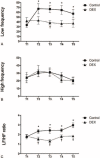Effect of Intraoperative Dexmedetomidine Infusion on Postoperative Bowel Movements in Patients Undergoing Laparoscopic Gastrectomy: A Prospective, Randomized, Placebo-Controlled Study
- PMID: 26091461
- PMCID: PMC4616550
- DOI: 10.1097/MD.0000000000000959
Effect of Intraoperative Dexmedetomidine Infusion on Postoperative Bowel Movements in Patients Undergoing Laparoscopic Gastrectomy: A Prospective, Randomized, Placebo-Controlled Study
Abstract
Sympathetic hyperactivation is one of the causes of postoperative ileus, which occurs frequently after abdominal surgery and adversely influences the patient's prognosis. We aimed to investigate whether dexmedetomidine (DEX) could attenuate postoperative ileus in patients undergoing laparoscopic gastrectomy. Ninety-two patients were randomized to the control (n = 46) or DEX group (n = 46). DEX was administered at a loading dose of 0.5 μg/kg for 10 minutes, followed by an infusion rate of 0.4 μg/kg/h from insufflation of the pneumoperitoneum to the end of surgery. The primary goal was to compare postoperative bowel movements by evaluating the time to first flatus. The balance of the autonomic nervous system, duration of postoperative hospital stay, and pain scores were assessed. The time to first flatus was shorter in the DEX group compared with the control group (67.2 ± 16.8 hours vs 79.9 ± 15.9 hours, P < 0.001). The low-frequency/high-frequency power ratio during pneumoperitoneum increased in the control group, compared with baseline values and the DEX group. The length of postoperative hospital stay was shorter in the DEX group compared with the control group (5.4 ± 0.7 days vs 5.8 ± 1.1 days, P = 0.04). Patients in the DEX group had lower pain scores and required fewer analgesics at 1 hour postoperatively. DEX facilitated bowel movements and reduced the length of hospital stay in patients undergoing laparoscopic gastrectomy. This may be attributed to the sympatholytic and opioid-sparing effects of DEX.
Conflict of interest statement
The authors have no funding and conflicts of interest to disclose.
Figures

References
-
- Holte K, Kehlet H. Postoperative ileus: a preventable event. Br J Surg 2000; 87:1480–1493. - PubMed
-
- Johnson MD, Walsh RM. Current therapies to shorten postoperative ileus. Cleve Clin J Med 2009; 76:641–648. - PubMed
-
- Bauer AJ, Boeckxstaens GE. Mechanisms of postoperative ileus. Neurogastroenterol Motil 2004; 16 suppl 2:54–60. - PubMed
-
- Lee MS, Lee JH, Park do J, et al. Comparison of short- and long-term outcomes of laparoscopic-assisted total gastrectomy and open total gastrectomy in gastric cancer patients. Surg Endosc 2013; 27:2598–2605. - PubMed
-
- Bickel A, Yahalom M, Roguin N, et al. Power spectral analysis of heart rate variability during positive pressure pneumoperitoneum: the significance of increased cardiac sympathetic expression. Surg Endosc 2002; 16:1341–1344. - PubMed
Publication types
MeSH terms
Substances
LinkOut - more resources
Full Text Sources
Medical

